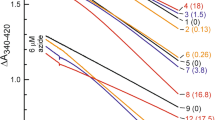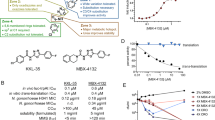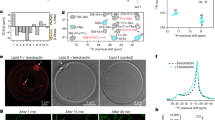Abstract
5′-Methylthioadenosine/S-adenosylhomocysteine nucleosidase (MTAN) is a bacterial enzyme involved in S-adenosylmethionine–related quorum sensing pathways that induce bacterial pathogenesis factors. Transition state analogs MT-DADMe-Immucillin-A, EtT-DADMe-Immucillin-A and BuT-DADMe-Immucillin-A are slow-onset, tight-binding inhibitors of Vibrio cholerae MTAN (VcMTAN), with equilibrium dissociation constants of 73, 70 and 208 pM, respectively. Structural analysis of VcMTAN with BuT-DADMe-Immucillin-A revealed interactions contributing to the high affinity. We found that in V. cholerae cells, these compounds are potent MTAN inhibitors with IC50 values of 27, 31 and 6 nM for MT-, EtT- and BuT-DADMe-Immucillin-A, respectively; the compounds disrupt autoinducer production in a dose-dependent manner without affecting growth. MT- and BuT-DADMe-Immucillin-A also inhibited autoinducer-2 production in enterohemorrhagic Escherichia coli O157:H7 with IC50 values of 600 and 125 nM, respectively. BuT-DADMe-Immucillin-A inhibition of autoinducer-2 production in both strains persisted for several generations and caused reduction in biofilm formation. These results support MTAN's role in quorum sensing and its potential as a target for bacterial anti-infective drug design.
This is a preview of subscription content, access via your institution
Access options
Subscribe to this journal
Receive 12 print issues and online access
$259.00 per year
only $21.58 per issue
Buy this article
- Purchase on Springer Link
- Instant access to full article PDF
Prices may be subject to local taxes which are calculated during checkout




Similar content being viewed by others
References
Fuqua, W.C., Winans, S.C. & Greenberg, E.P. Quorum sensing in bacteria: the LuxR-LuxI family of cell density-responsive transcriptional regulators. J. Bacteriol. 176, 269–275 (1994).
Sperandio, V. Novel approaches to bacterial infection therapy by interfering with bacteria-to-bacteria signaling. Expert Rev. Anti Infect. Ther. 5, 271–276 (2007).
Vendeville, A., Winzer, K., Heurlier, K., Tang, C.M. & Hardie, K.R. Making 'sense' of metabolism: autoinducer-2, LuxS and pathogenic bacteria. Nat. Rev. Microbiol. 3, 383–396 (2005).
Cegelski, L., Marshall, G.R., Eldridge, G.R. & Hultgren, S.J. The biology and future prospects of antivirulence therapies. Nat. Rev. Microbiol. 6, 17–27 (2008).
Winzer, K. & Williams, P. Quorum sensing and the regulation of virulence gene expression in pathogenic bacteria. Int. J. Med. Microbiol. 291, 131–143 (2001).
Stroeher, U.H., Paton, A.W., Ogunniyi, A.D. & Paton, J.C. Mutation of luxS of Streptococcus pneumoniae affects virulence in a mouse model. Infect. Immun. 71, 3206–3212 (2003).
Winzer, K. et al. Role of Neisseria meningitidis luxS in cell-to-cell signaling and bacteremic infection. Infect. Immun. 70, 2245–2248 (2002).
Harasawa, H. et al. Chemotherapy targeting methylthioadenosine phosphorylase (MTAP) deficiency in adult T cell leukemia (ATL). Leukemia 16, 1799–1807 (2002).
Basu, I. et al. A transition state analogue of 5′-methylthioadenosine phosphorylase induces apoptosis in head and neck cancers. J. Biol. Chem. 282, 21477–21486 (2007).
Singh, V., Lee, J.E., Nunez, S., Howell, P.L. & Schramm, V.L. Transition state structure of 5′-methylthioadenosine/S-adenosylhomocysteine nucleosidase from Escherichia coli and its similarity to transition state analogues. Biochemistry 44, 11647–11659 (2005).
Singh, V. & Schramm, V.L. Transition-state analysis of S-pneumoniae 5′-methylthioadenosine nucleosidase. J. Am. Chem. Soc. 129, 2783–2795 (2007).
Singh, V., Luo, M., Brown, R.L., Norris, G.E. & Schramm, V.L. Transition-state structure of Neisseria meningitides 5′-methylthioadenosine/S-adenosylhomocysteine nucleosidase. J. Am. Chem. Soc. 129, 13831–13833 (2007).
Singh, V. & Schramm, V.L. Transition-state structure of human 5′-methylthioadenosine phosphorylase. J. Am. Chem. Soc. 128, 14691–14696 (2006).
Balakrishnan, K., Nimmanapalli, R., Ravandi, F., Keating, M.J. & Gandhi, V. Forodesine, an inhibitor of purine nucleoside phosphorylase, induces apoptosis in chronic lymphocytic leukemia cells. Blood 108, 2392–2398 (2006).
Robak, T., Lech-Maranda, E., Koerycka, A. & Robak, E. Purine nucleoside analogs as immunosuppressive and antineoplastic agents: mechanism of action and clinical activity. Curr. Med. Chem. 13, 3165–3189 (2006).
Evans, G.B., Furneaux, R.H., Schramm, V.L., Singh, V. & Tyler, P.C. Targeting the polyamine pathway with transition-state analogue inhibitors of 5′-methylthioadenosine phosphorylase. J. Med. Chem. 47, 3275–3281 (2004).
Evans, G.B. et al. Second generation transition state analogue inhibitors of human 5′-methylthioadenosine phosphorylase. J. Med. Chem. 48, 4679–4689 (2005).
Singh, V. et al. Femtomolar transition state analogue inhibitors of 5′-methylthioadenosine/S-adenosylhomocysteine nucleosidase from Escherichia coli. J. Biol. Chem. 280, 18265–18273 (2005).
Singh, V. et al. Picomolar transition state analogue inhibitors of human 5′-methylthioadenosine phosphorylase and X-ray structure with MT-Immucillin-A. Biochemistry 43, 9–18 (2004).
Singh, V. et al. Structure and inhibition of a quorum sensing target from Streptococcus pneumoniae. Biochemistry 45, 12929–12941 (2006).
Gutierrez, J.A. et al. Picomolar inhibitors as transition-state probes of 5′-methylthioadenosine nucleosidases. ACS Chem. Biol. 2, 725–734 (2007).
Lee, J.E. et al. Structural rationale for the affinity of pico- and femtomolar transition state analogues of Escherichia coli 5′-methylthioadenosine/S-adenosylhomocysteine nucleosidase. J. Biol. Chem. 280, 18274–18282 (2005).
Bassler, B.L., Greenberg, E.P. & Stevens, A.M. Cross-species induction of luminescence in the quorum-sensing bacterium Vibrio harveyi. J. Bacteriol. 179, 4043–4045 (1997).
Saen-Oon, S., Ghanem, M., Schramm, V.L. & Schwartz, S.D. Remote mutations and active site dynamics correlate with catalytic properties of purine nucleoside phosphorylase. Biophys. J. 94, 4078–4088 (2008).
Anand, S.K. & Griffiths, M.W. Quorum sensing and expression of virulence in Escherichia coli O157:H7. Int. J. Food Microbiol. 85, 1–9 (2003).
Sperandio, V., Mellies, J.L., Nguyen, W., Shin, S. & Kaper, J.B. Quorum sensing controls expression of the type III secretion gene transcription and protein secretion in enterohemorrhagic and enteropathogenic Escherichia coli. Proc. Natl. Acad. Sci. USA 96, 15196–15201 (1999).
Li, J. et al. Quorum sensing in Escherichia coli is signaled by AI-2/LsrR: effects on small RNA and biofilm architecture. J. Bacteriol. 189, 6011–6020 (2007).
Herzberg, M., Kaye, I.K., Peti, W. & Wood, T.K. YdgG (TqsA) controls biofilm formation in Escherichia coli K-12 through autoinducer 2 transport. J. Bacteriol. 188, 587–598 (2006).
Zhu, J. & Mekalanos, J.J. Quorum sensing-dependent biofilms enhance colonization in Vibrio cholerae. Dev. Cell 5, 647–656 (2003).
Matz, C. et al. Biofilm formation and phenotypic variation enhance predation-driven persistence of Vibrio cholerae. Proc. Natl. Acad. Sci. USA 102, 16819–16824 (2005).
Hammer, B.K. & Bassler, B.L. Quorum sensing controls biofilm formation in Vibrio cholerae. Mol. Microbiol. 50, 101–114 (2003).
Waters, C.M., Lu, W., Rabinowitz, J.D. & Bassler, B.L. Quorum sensing controls biofilm formation in Vibrio cholerae through modulation of cyclic di-GMP levels and repression of vpsT. J. Bacteriol. 190, 2527–2536 (2008).
Zhu, J. et al. Quorum-sensing regulators control virulence gene expression in Vibrio cholerae. Proc. Natl. Acad. Sci. USA 99, 3129–3134 (2002).
Joelsson, A., Liu, Z. & Zhu, J. Genetic and phenotypic diversity of quorum-sensing systems in clinical and environmental isolates of Vibrio cholerae. Infect. Immun. 74, 1141–1147 (2006).
Gonzalez Barrios, A.F. et al. Autoinducer 2 controls biofilm formation in Escherichia coli through a novel motility quorum-sensing regulator (MqsR, B3022). J. Bacteriol. 188, 305–316 (2006).
Surette, M.G. & Bassler, B.L. Quorum sensing in Escherichia coli and Salmonella typhimurium. Proc. Natl. Acad. Sci. USA 95, 7046–7050 (1998).
Dunny, G.M. & Leonard, B.A.B. Cell-cell communication in gram-positive bacteria. Annu. Rev. Microbiol. 51, 527–564 (1997).
Balestrino, D., Haagensen, J.A.J., Rich, C. & Forestier, C. Characterization of type 2 quorum sensing in Klebsiella pneumoniae and relationship with biofilm formation. J. Bacteriol. 187, 2870–2880 (2005).
Joyce, E.A. et al. LuxS is required for persistent Pneumococcal carriage and expression of virulence and biosynthesis genes. Infect. Immun. 72, 2964–2975 (2004).
Rader, B.A., Campagna, S.R., Semmelhack, M.F., Bassler, B.L. & Guillemin, K. The quorum-sensing molecule autoinducer 2 regulates motility and flagellar morphogenesis in Helicobacter pylori. J. Bacteriol. 189, 6109–6117 (2007).
Otwinowski, Z. & Minor, W. Processing of X-ray diffraction data collected in oscillation mode. Methods Enzymol. 276, 307–326 (1997).
Potterton, E., Briggs, P., Turkenburg, M. & Dodson, E. A graphical user interface to the CCP4 program suite. Acta Crystallogr. D Biol. Crystallogr. 59, 1131–1137 (2003).
Vagin, A. & Teplyakov, A. MOLREP: an automated program for molecular replacement. J. Appl. Crystallogr. 30, 1022–1025 (1997).
Murshudov, G.N., Vagin, A.A. & Dodson, E.J. Refinement of macromolecular structures by the maximum-likelihood method. Acta Crystallogr. D Biol. Crystallogr. 53, 240–255 (1997).
Emsley, P. & Cowtan, K. Model-building tools for molecular graphics. Acta Crystallogr. D Biol. Crystallogr. 60, 2126–2132 (2004).
DeLano, W.L. The PyMOL Molecular Graphics System (DeLano Scientific, Palo Alto, California, USA, 2002).
Greenberg, E.P., Hastings, J.W. & Ulitzur, S. Induction of luciferase synthesis in Beneckea harveyi by other marine bacteria. Arch. Microbiol. 120, 87–91 (1979).
O'Toole, G.A. et al. Genetic approaches to study of biofilms. Methods Enzymol. 310, 91–109 (1999).
Parsek, M.R., Val, D.L., Hanzelka, B.L., Cronan, J.E. & Greenberg, E.P. Acyl homoserine-lactone quorum-sensing signal generation. Proc. Natl. Acad. Sci. USA 96, 4360–4365 (1999).
Acknowledgements
We acknowledge R.H. Furneaux, G.B. Evans, D.H. Lenz, G.F. Painter and P.C. Tyler of Industrial Research Laboratory, Inc. for supplying the DADMe-Immucillins; M.G. Surette (University of Calgary) for providing V. harveyi strains BB120 and BB170; C. Bradbeer (University of Virginia) for the E. coli MTAN knockout; and the US National Institutes of Health grant GM41916 for funding. Data for this study were collected at beamline X29A of the National Synchrotron Light Source. Financial support comes principally from the Offices of Biological and Environmental Research and of Basic Energy Sciences of the US Department of Energy, and from the National Center for Research Resources of the US National Institutes of Health.
Author information
Authors and Affiliations
Contributions
J.A.G. performed the inhibition assays on recombinant VcMTAN and on E. coli and V. cholerae cells, and co-wrote the manuscript. T.C. expressed, purified and measured activity of the recombinant VcMTAN. A.R.-M., M.-C.H. and S.C.A. did the structure determination, refinement and characterization for the VcMTAN–BuT-DADMe-ImmA complex. V.L.S. designed the experiments and co-wrote the manuscript.
Corresponding author
Ethics declarations
Competing interests
V.L.S. is co-scientific founder of Pico Pharmaceuticals Inc., a new startup biotechnology company involved in anticancer and antibiotic development.
Supplementary information
Supplementary Text and Figures
Supplementary Figures 1–3, Supplementary Tables 1 and 2, and Supplementary Methods (PDF 334 kb)
Rights and permissions
About this article
Cite this article
Gutierrez, J., Crowder, T., Rinaldo-Matthis, A. et al. Transition state analogs of 5′-methylthioadenosine nucleosidase disrupt quorum sensing. Nat Chem Biol 5, 251–257 (2009). https://doi.org/10.1038/nchembio.153
Received:
Accepted:
Published:
Issue Date:
DOI: https://doi.org/10.1038/nchembio.153
This article is cited by
-
Identification of immucillin analogue natural compounds to inhibit Helicobacter pylori MTAN through high throughput virtual screening and molecular dynamics simulation
In Silico Pharmacology (2021)
-
Novel Treatment Strategies for Biofilm-Based Infections
Drugs (2019)
-
Searching for potent and specific antibiotics against pathogenic Helicobacter and Campylobacter strains
Journal of Industrial Microbiology and Biotechnology (2019)
-
Quorum sensing in thermophiles: prevalence of autoinducer-2 system
BMC Microbiology (2018)
-
Designer cells programming quorum-sensing interference with microbes
Nature Communications (2018)



